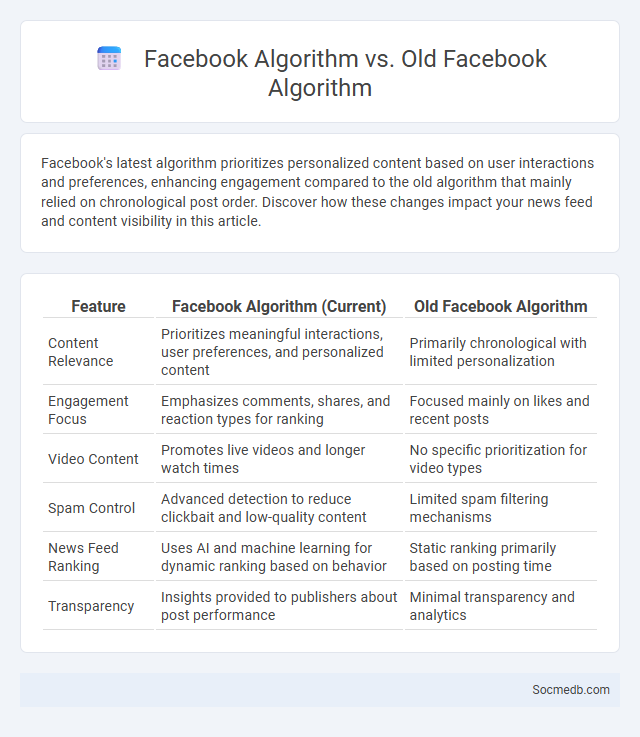
Photo illustration: Facebook Algorithm vs Old Facebook Algorithm
Facebook's latest algorithm prioritizes personalized content based on user interactions and preferences, enhancing engagement compared to the old algorithm that mainly relied on chronological post order. Discover how these changes impact your news feed and content visibility in this article.
Table of Comparison
| Feature | Facebook Algorithm (Current) | Old Facebook Algorithm |
|---|---|---|
| Content Relevance | Prioritizes meaningful interactions, user preferences, and personalized content | Primarily chronological with limited personalization |
| Engagement Focus | Emphasizes comments, shares, and reaction types for ranking | Focused mainly on likes and recent posts |
| Video Content | Promotes live videos and longer watch times | No specific prioritization for video types |
| Spam Control | Advanced detection to reduce clickbait and low-quality content | Limited spam filtering mechanisms |
| News Feed Ranking | Uses AI and machine learning for dynamic ranking based on behavior | Static ranking primarily based on posting time |
| Transparency | Insights provided to publishers about post performance | Minimal transparency and analytics |
Introduction to Facebook Algorithms
Facebook algorithms prioritize content based on user interactions, relevance, and engagement to deliver a personalized feed. By analyzing your past behavior, interests, and connections, these algorithms determine which posts appear prominently in your timeline. Understanding how Facebook ranks posts can help you optimize your content strategy for better visibility and engagement.
Evolution of the Facebook Algorithm
The Facebook algorithm has evolved significantly since its inception, shifting from a simple chronological feed to a complex, AI-driven system prioritizing user engagement and personalized content. Early updates focused on showing posts from friends and family, while recent changes emphasize meaningful interactions, video content, and community groups. Continuous improvements leverage machine learning and user behavior analytics to enhance relevance and combat misinformation.
Key Features of the Old Facebook Algorithm
The old Facebook algorithm prioritized content from friends and family over public posts, promoting posts with high engagement such as likes, comments, and shares to increase visibility in users' News Feeds. It emphasized chronological recency combined with user interaction history, ensuring more relevant and timely content surfaced. Posts with rich media, including photos and videos, were favored, driving higher engagement rates and extended user session times.
Major Changes in the New Facebook Algorithm
The new Facebook algorithm prioritizes meaningful interactions by favoring content that sparks genuine conversations and engagement among users. It reduces the visibility of passive content such as clickbait and viral videos, shifting focus towards posts from friends, family, and community groups. Brands and creators must now emphasize authentic engagement and quality content to maintain reach and relevance on the platform.
Differences Between Old and New Facebook Algorithms
The differences between old and new Facebook algorithms primarily lie in content prioritization and user engagement metrics; the old algorithm favored posts with higher likes and comments, while the new algorithm emphasizes meaningful interactions such as shares, comments, and time spent on content. Machine learning techniques now play a significant role in analyzing user behavior to personalize feeds, increasing the relevance of posts from friends, family, and groups over public pages or advertisers. This shift affects organic reach and requires marketers to focus on creating authentic, engaging content that encourages active participation rather than passive reactions.
How Algorithms Shape Facebook Content
Facebook's algorithms prioritize content based on user engagement, relevance, and interaction history, shaping the information you see in your feed. These systems analyze your behavior, such as likes, comments, and shares, to deliver personalized posts and advertisements tailored to your interests. Understanding how Facebook's algorithm works helps you navigate and manage the content that influences your online experience.
Impact on User Engagement and Experience
Social media platforms significantly enhance user engagement by offering personalized content, interactive features, and real-time communication tools tailored to Your preferences. Algorithms analyze behavior to deliver relevant posts, increasing time spent and interaction rates, which boosts overall user satisfaction. These dynamic experiences foster community-building and immediate feedback, elevating the quality of Your social media interactions.
Algorithm Transparency and User Trust
Algorithm transparency on social media platforms is crucial for building and maintaining user trust by allowing You to understand how content is prioritized and recommended. Clear disclosures about data usage and content ranking criteria empower users to make informed decisions and reduce skepticism about manipulation or bias. Enhancing transparency leads to increased accountability, fostering a more trustworthy digital environment.
Optimizing Content for the Current Algorithm
To optimize content for the current social media algorithm, focus on creating high-quality, engaging posts that encourage interactions such as comments, shares, and likes. Use relevant keywords, hashtags, and trending topics to boost visibility and reach your target audience effectively. Your content should prioritize authenticity and consistency to maintain algorithmic favor and foster lasting engagement.
Future Trends in Social Media Algorithms
Future trends in social media algorithms will increasingly prioritize personalized content delivery driven by advanced AI and machine learning techniques, enhancing user engagement by predicting your interests more accurately. Algorithms will also integrate real-time data analysis to adapt content dynamically, fostering authentic interactions and mitigating misinformation. Enhanced transparency and user control features will become standard, empowering your digital experience with greater privacy and customization options.
 socmedb.com
socmedb.com